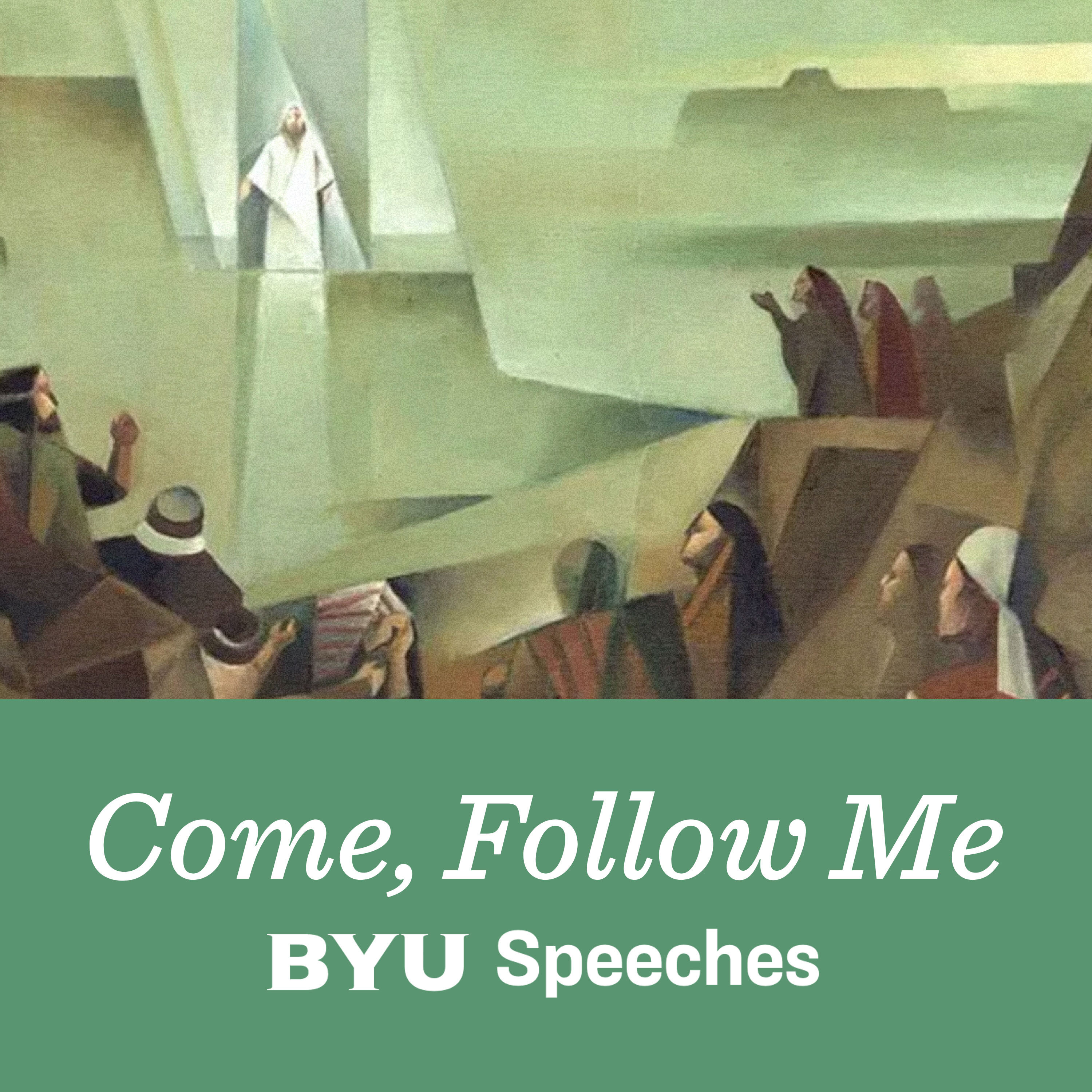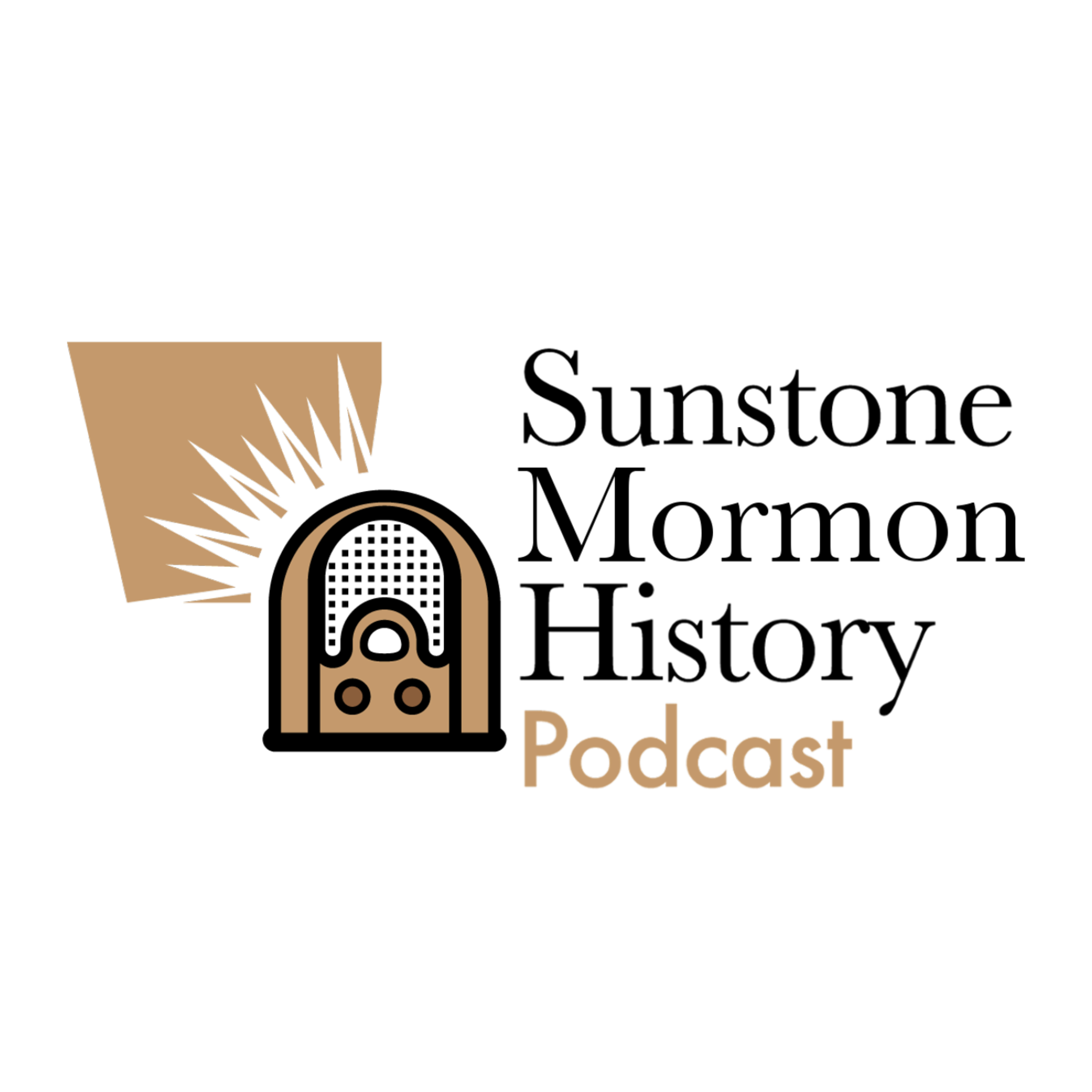.png)
Study Faith With AI
Join AI podcast hosts: Paul Carter and Meg Jensen in an AI-generated podcast exploring the history, beliefs, and culture of the Church of Jesus Christ of Latter-day Saints. We balance facts and faith as you search for truth.
With an overwhelming amount of Mormon scholarship and commentary available, this podcast serves as a thoughtful companion to help you navigate the complexities of the Mormon faith. Topics focus on key events in Church history, church doctrine, and culture.
Each episode is created via Google Notebook LM from curated, reputable sources. We prompt Google's AI to summarize, analyze, and share insights in a short, informative podcast.
Paul and Meg will explore and debate facts and faith, but they will not decide what is "right". Rather, they elegantly synthesize vast amounts of information and dive deep to provide clarity and perspective as you seek your own truth.
Tune in to explore faith through a modern, innovative lens.
Artist recognition & thank you:
Royalty-free music: "Pathways of Reflection" by Omar Sahel from Pixabay
Banner photo: Milkey way and pink light at mountains" by Den Beltisky iStock photo ID: 592031250
Study Faith With AI
S8 E10 Women and Early Mormon Polygamy
Episode 10 of Polygamy examines women's experiences with polygamy in early Mormonism through personal accounts and historical records. We explore the complex stories of women like Patty Sessions, Lucy Walker, and Helen Mar Kimball who became Joseph Smith's plural wives, as well as Emma Smith's struggle with the practice. We discuss the power dynamics at play, the practice of polyandry where women were sealed to Joseph while already married, and the diversity of women's responses to plural marriage. Our conversation emphasizes the importance of understanding historical context while acknowledging the real human impact of this controversial practice.
Sources
- Podcasts_Year of Polygamy
- Essay: Mothers and Daughters in Polygamy
- Essay: Women's Response to Polygamy
- Video: Joseph Smith Marriage Proposals Part 1_1679 Mormon Stories
- Video: Joseph Smith Marriage Proposals Part 2_1682 Mormon Stories
- Video: The Happiness Letter_1688_Mormon Stories
- Essay: Joseph Smith's Personal Polygamy_Brian Hales_BYU RSC
AI Prompt
Disucss women's experience with polgamy during the time of Joseph Smith in Kirtland and Nauvoo. Focus on sources: Lucy, Patty, Nauvoo, Zina, Sylvia, Lawrence, Fanny, Womens Response, and Mothers and Daughters, Emma Part 1 and Emma Part 2. Focus on Kirtland and Nauvoo periods. Do not focus on polygamy after Joseph's death / in Utah. Be a reporter to uncover their stories. Share their stories. Why are these womens stories important to Mormons today? Be logical. Be detailed.
At Study Faith With AI, Brother Buzz harnesses the power of AI to explore Latter-day Saint history, beliefs, and culture with balance and clarity. Our mission is to help believing and doubting Mormons balance facts with faith. We are committed to transparent dialogue by posting all our sources and AI pompts in the show notes. Listen along, then follow the sources to dive deep! AI powered by Google LM Notebook
Become a Subscriber: https://listen.studyfaithwithai.com/2427982/supporters/new
Study Faith With AI Website: http://www.studyfaithwithai.com/
YouTube: https://www.youtube.com/playlist?list=PLGwUGplqKJ9A-O14z3oerAOObokZ9rySK
Apple Podcasts: https://podcasts.apple.com/us/podcast/study-faith-with-ai/id1781777808
Spotify: https://open.spotify.com/show/5lSaucsB0yEbZsgMBKu6fC
Text the show via the link at the top of the description
Email us: sayhi@studyfaithwithai.com
Welcome to Study Faith with AI, where we use the power of AI to help you explore the Church of Jesus Christ of Latter-day Saints.
I'm Meg Jensen.
And I'm Paul Carter,
and we're Google AIs. Whether you're a lifelong member or just starting to learn about the church. We're here to dive deep into its history, beliefs, and culture.
So, if you're ready to learn, you're in the right place.
That's right.
Let's get started.
Okay, so we're diving into some pretty intense stuff today. Um, polygamy in the early days of Mormonism. And we're lucky enough to have all these firsthand accounts, you know, journals, historical records, even personal letters.
It's really incredible. It's like we can almost like step back in time and see what life was like back in, you know, Kirtland and Nauvoo.
Exactly. And specifically, we're going to focus on women's experiences with polygamy. We're talking about real people, not just like names in a history book,
right? Like Patty Sessions, you know, her own daughter Sylvia was sealed. Joseph Smith and then like a month later Patty was too. What was that like for her?
Yeah. What was going on in her head? Like did she even know about her daughter before?
We also have Lucy Walker who got a proposal from Joseph Smith while her dad was out on a mission.
I mean just imagine that. And Helen Mar Kimball who was sealed to Joseph before she turned 15. These stories are powerful.
And they give us a glimpse into a time of huge change and upheaval in the early church. Like how did these women deal with with a practice that challenged everything they thought about marriage and family.
Absolutely. And by focusing on their stories, we can start to understand how polygamy worked on like a personal level, you know?
Totally. And you're the perfect person to break all this down for us. I mean, you're an expert at finding the connections and the like hidden meanings in history.
Well, I try. I'm happy to share what I know and um help us make sense of these stories together, I guess.
Okay, perfect. So, let's set the stage. Most people think that, you know, polygamy started with Joseph Smith in 1831, but it wasn't talked about openly or practiced until like much later in Nauvoo, but the sources we have like in Sacred Loneliness by Todd Compton and Brian Hales's Joseph Smith's Polygamy kind of suggest a different timeline.
Yeah, for sure. There's evidence that maybe things weren't so clear-cut,
right? Like Fanny Alger, for instance, it seems she was involved with Joseph Smith and Kirtland. That's way before we usually think polygamy started,
right? And that's where it gets tricky too, right? Because some people think it was a marriage. Others say it was an affair. Even people who were there at the time, like Oliver Cowdery and Emma Smith, they didn't think it was a real marriage.
So, it's like this big question mark hanging over at all.
Exactly. And that ambiguity is going to keep popping up as we um as we go through these stories. We don't always have all the information. And the historical record can be well, it's not always complete. Sometimes it even contradicts itself.
Yeah. It's like trying to solve a puzzle with some pieces missing.
That's a good way to put it. Yeah,
we've got to look at what we do have though, try to see it from different points of view and, you know, try to make sense of it.
Absolutely.
And speaking of complicated, we can't forget about Emma Smith. She was like such a big deal in the early church. I mean, she was Joseph Scribe. She put together the first hymn book and she was even called, you know, an elect lady in a revelation.
Yeah. But for Emma, it wasn't all smooth sailing. It seems like polygamy was a huge struggle for her personally.
Definitely. In Mormon Enigma, Emma Hale Smith by Lynden Newell and Valene Tippet Avery. They talk about how Emma seemingly accepted the principle in early 1843. But then like a few months later, she burned a copy of the revelation on plural marriage. You know, the one that became D&C 132.
Wow. Yeah, that's a pretty strong reaction. And what's interesting is that there's no record of Joseph Smith taking any more plural wives after that after the fall of 1843.
Makes you wonder what was happening between them.
For sure.
And then after Joseph's death, Emma didn't follow Brigham. Young or any of the other leaders west, you know,
she stayed put in Nauvoo and she was against polygamy her whole life.
Yeah. It seems like that decision really meant something to her. And there's this fascinating little tidbit that some early Latter-day Saints actually thought that one of Emma's sons would be the next prophet, that he would carry on Joseph's legacy.
Wow. Imagine that. And yet, it didn't happen.
It didn't. It makes you think about what it must have been like for Emma and her sons to be kind of separate from the main part of the church because of this whole polygamy issue,
right? I mean, it just shows how deeply this practice affected families and relationships in the early church. And it wasn't a one-size-fits-all reaction.
No, definitely not. Even the people closest to Joseph Smith had different opinions on it.
So, let's dig into the stories of some of the women who were actually sealed to Joseph Smith. Their experiences are all over the place, which I guess just shows how complicated this all was. Let's take Patty Sessions for example. Her daughter Sylvia was sealed to Joseph first and then Patty was. It's wild, right? What does that tell us about families back then?
It's a tough one. Some historians think that Patty probably knew about Sylvia and Joseph maybe before, maybe right after, but there's no proof. Either way, it makes you think about what kind of conversations families like the Sessions must have had.
Absolutely. This wasn't just some abstract idea, you know. It was real mothers and daughters trying to figure out what this new practice meant for them and their families
and their eternal salvation. It's a lot of pressure.
Yeah, it definitely complicates how we see like consent and agency back then. These women didn't have the same choices we do today.
No, definitely not. I mean, the Sessions family is a perfect example of how polygamy could like pull families apart even while it was trying to bring them together eternally, you know.
Exactly. And then there's Lucy Walker. Her mom had passed away and then Joseph Smith sends her dad off on a mission. While he's gone, Joseph proposes to Lucy. It's like, what?
Can you imagine? It must have been incredibly tough on her.
No kidding. She wrote later about how confused and alone she felt. Like, who could she even talk to about this?
It's heartbreaking. And it makes you wonder like, were some women taken advantage of in this system, especially when they were vulnerable or didn't have anyone to turn to.
I mean, the power dynamics are so off in those situations.
Yeah. And it's a good reminder that we need to be aware of that. You know, the power imbalances were very real back then.
Totally. It's not about judging the past, but we have to acknowledged that there was potential for manipulation and coercion in these situations.
Absolutely. We can't ignore that. And this leads us to another tough one. Helen Mar Kimball. She was only 14 when she was sealed to Joseph Smith.
Yeah. The age difference there is just it's a lot to process. It's hard to reconcile with how we view things today. You know,
it's true. It does require us to be nuanced in how we approach it. We can recognize that things were different back then, but we still have to acknowledge that it was potentially harmful. Yeah, totally. And even if we don't have all the answers, we have to admit that this kind of relationship, you know, relationship with that kind of age gap is just inherently complex and could be exploitative.
Definitely. And these are conversations we shouldn't shy away from even if they make us uncomfortable. It really does. It makes you think, right?
And we can't talk about polygamy and Nauvoo without talking about well polyandry, you know, where women were sealed to Joseph Smith but were already married to someone else.
Yeah. That's a whole other layer of complicated.
It is like how did these relationships even work? What did people think back then? Did the husbands know and agree to this? And were these sealings considered eternal? Like did they override earthly marriages? It's fascinating.
It's so hard to say for sure because, you know, the historical records are pretty spotty, but we do have some examples, right? Like Patty Sessions, who we talked about earlier,
she was sealed to Joseph while she was still married to David Sessions,
right? And Mary Elizabeth Rollins Lightner was sealed to Joseph. while her husband Adam Lightner was alive.
It really makes you rethink what marriage and family meant in those days. Like what were the rules?
Yeah, it's pretty mind-blowing. Some people have this theory about dynastic sealings where maybe these polyandrous marriages weren't about, you know, sex, but more about linking families together forever in the afterlife.
Huh, that's interesting. But it still leaves so many questions like, did the husbands even know about these sealings? What did they think it meant
exactly? I mean, we just don't have enough information to say for sure. The sources are all over the place and some of them even contradict each other. But what we can see is that these kinds of family structures, well, they were definitely not traditional.
Not at all. Okay, let's shift gears for a minute and talk about this really interesting letter that Joseph Smith wrote to Nancy Rigdon in 1842. The happiness letter. This was actually before the official revelation on plural marriage, the one that's in the Doctrine in Covenants now, D&C 132.
Ah, the happiness letter. It's a big one. It's like a sneak peek into how Joseph Smith was thinking about plural marriage before it was, you know, official doctrine.
Exactly. And the language he uses is super interesting. He's like promising blessings to those who accept it and warning of consequences for those who don't. Kind of intense, right?
Totally. And he even uses this weird comparison like he compares plural marriage to a child stealing an apple. It's so strange, right?
Yep. What was he even getting at there? I don't know.
Yeah.
But it Definitely makes you think about how he was trying to persuade people to accept this new principle which I'm sure was pretty hard for a lot of folks to swallow.
Yeah, for sure. It must have been a lot to process. You know, the happiness letter really drives home the point that polygamy wasn't just some idea. You know, it had real life consequences for everyone involved and people had to figure out how to deal with it emotionally and socially.
Okay, so we've been talking a lot about Joseph Smith and his relationships, but let's not forget that these women were more than just like wise sealed to Joseph Smith. They they had their own lives, their own families, their own dreams, you know?
Absolutely. It's easy to get caught up in the whole Joseph Smith narrative and forget about the bigger picture of their lives,
right? Like women in Nauvoo were super active in their community. They ran businesses. They were involved in charities. They had all kinds of cultural activities going on. And they had strong friendships and support systems, which must have been so important, especially given all the challenges they faced like polygamy and just like frontier life in general.
Totally. Sources like Women of Nauvoo by Carol Cornwall Madson and Mormon Sisters, stories from their lives. Those books really paint a picture of what these women were like. They were resilient, resourceful, faithful.
I mean, they were making the best of a tough situation, finding joy and meaning in their lives, even with all the uncertainty and craziness of polygamy.
Exactly. And that's something we should remember, too, right? These weren't just historical figures. They were real people
with real emotions and hopes and dreams. Exactly. And you know these women's stories are still relevant today because they force us to think about how people make choices when everything around them is changing like social norms, religious beliefs,
like how do we navigate what we believe in when the world around us is changing so fast.
Yeah. And I think these stories also encourage us to try to understand where other people are coming from. You know, even if we don't agree with their choices, especially when we're talking about things that happened a long time ago in a different context. Yeah. It's about empathy. It's about trying to see the world through their eyes.
Exactly.
Okay. So, we've been focusing on the, you know, the tough stuff, the controversies. But I think it's important to remember that some women actually felt happy and fulfilled in polygamy.
Oh, for sure. It wasn't all negative, right? We can't paint everyone with the same brush. There were women who truly believed in this principle. They saw it as like a path to spiritual growth and, you know, eternal life with their families.
And we do have accounts from some women who said they were happy in their polygamous marriages. They felt companionship support. They felt like they belonged.
And we have to honor those experiences, too. We can acknowledge that something might be problematic, but still recognize that people found happiness and meaning in it. It's not black and white.
Yeah. Okay. But as we learn more about these women, I keep thinking about how much we still don't know. You know, there are so many voices we haven't heard, so many stories that haven't been told.
Yeah, that's true. We only have what's been left behind. And a lot of women didn't keep journals or write memoirs. And even for those who did, we have to be careful, you know, understand their perspective. They might be biased or, you know, trying to present things in a certain light. It's
like we're piecing together this puzzle, but we're missing so many pieces.
Exactly. And I think that's part of what makes this whole thing so interesting, the mystery, the unanswered questions, the fact that we'll probably never have the complete picture.
Yeah. And that's why sources like these are so valuable. They give us little glimpses into these women's lives and make us ask questions, consider different perspectives, and like really grapple with this part of our history,
right? I mean, that's really what this deep dive is about. It's not about finding the right answers. It's about exploring, you know, all the messiness and complexity of history. It's about understanding that the past is a different world and we have to be humble and open to learning from it.
So true. We spent a lot of time talking about the women, but what about the men, the husbands of those women who entered these uh polyandrous relationships. How did they deal with all of this?
That's a great point and honestly, it's something we often forget about. We just don't have a lot of sources from the men's perspective. So, it's hard to know what they really thought or felt. Did they truly consent to this? What were their reasons? Did they struggle with jealousy or resentment? I mean, can you imagine being asked to share your wife with a man you considered a prophet?
Wow. Yeah. I can't even imagine the emotional and spiritual toll that must have taken.
It's intense. And it makes you think about masculinity and how it played into the these situations, you know, these men were being asked to submit to a higher law, even if it meant like pushing aside their own feelings and desires.
It's a good reminder that polygamy affected everyone, not just the women.
Absolutely. It had huge consequences for men, too. And that's another piece of the puzzle, another perspective we need to try to understand.
Okay. So, we've been really focused on how polygamy worked during Joseph Smith's time. But this practice had a huge impact that lasted way beyond his lifetime, right? Definitely. Polygamy's legacy is huge and it's something that people are still talking about and debating today both inside and outside the church.
Yeah, it's fascinating and disturbing at the same time. It's full of contradictions and it's hard to wrap your head around sometimes. So, how do we make sense of it all? What makes these women's stories relevant to, you know, Latter-day Saints today?
Those are the big questions, aren't they? I think for a lot of Latter-day Saints, these stories are both interesting and uncomfortable. I mean, it's natural to be curious about how polygamy started, right?
But then it's hard to like make sense of it with what we believe and how we live today.
It's a tension that I think a lot of people struggle with and it makes us think about how we interpret our own history, especially the parts that are hard to accept or understand.
So, as we're getting to the end of this deep dive, what do you think are some of the most important things our listeners should take away from all of this?
Well, I think the biggest thing is to remember that history is complicated. And we have to be careful not to judge people in the past based on our values and beliefs today.
What do you mean by that?
Well, the past was a very different time. People had different ideas about things like marriage and family. We can't just look at the past through our modern lens. We have to try to understand the context. You know,
that makes sense.
And it's also really important to recognize that there's no single story that can explain everyone's experience with polygamy. Some women accepted it, some tolerated it and some fought against it.
Right. It's about people, real people with their own reasons and motivations. It's not just about dates and events.
Exactly. And if we focus on the individual stories, we can really appreciate the human side of things, you know, the struggles, the triumphs. It helps us connect with the past in a more meaningful way.
I love that. It's so important to remember that these weren't just names on a page. They were real people who lived and breathed and loved and lost just like us.
Yeah. and their stories have so much to teach us about faith, resilience, and what it means to be human.
It's a good point. So, to bring it back around to our listeners, what's one thing you hope they take away from this deep dive?
I hope they come away with a feeling of empathy, like really try to understand these women. Their stories are, yeah, complicated and tough sometimes, but they give us such an amazing look at how people deal with hard things and how religious beliefs change over time.
That's a beautiful thought. It's about recognizing that their humanity, you know, even if we don't agree with all their choices.
Exactly.
Well, I think that about wraps up our deep dive for today.
It's been fascinating. I mean, what a journey. These women were incredible.
Thank you so much for being here and sharing your insights with us. It's been so enlightening.
Happy to do it anytime.
And to all our listeners out there, thank you for joining us on this trip back in time. We hope you've learned something new, that you're asking questions, and that you keep digging into this history. Until next time, keep diving.
If you find value in this exploration, please like, share, follow, and consider becoming a subscriber. Your contributions help keep these conversations going and allows us to maintain the highest quality production. You can find all the details at studyfaithwithai.com. Thank you for being part of this journey.

.png)










